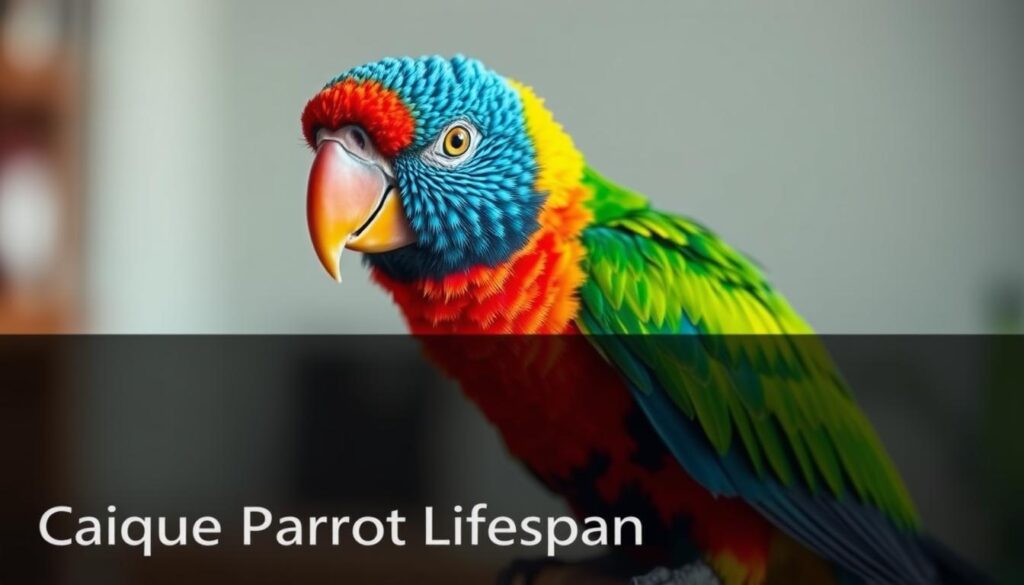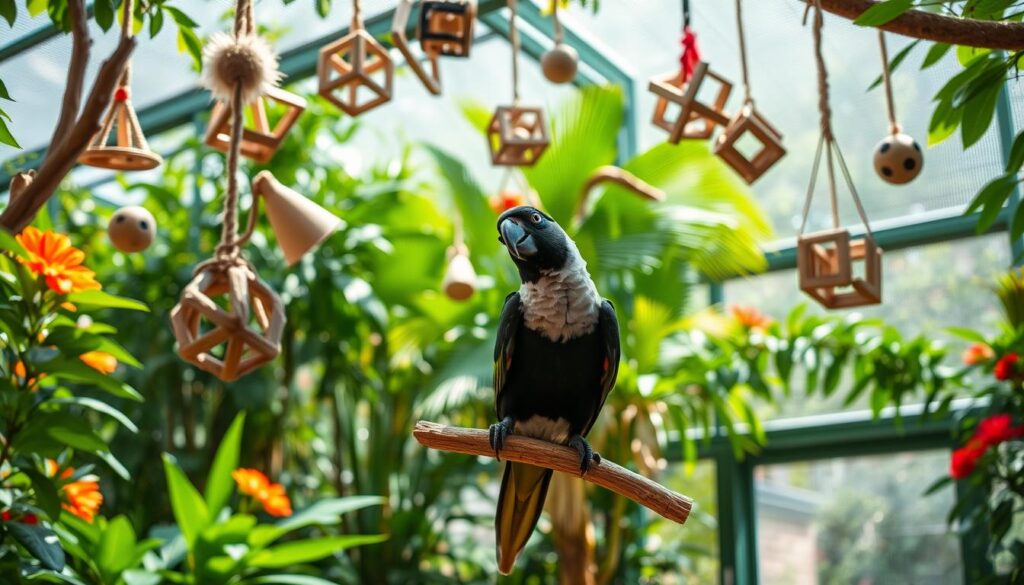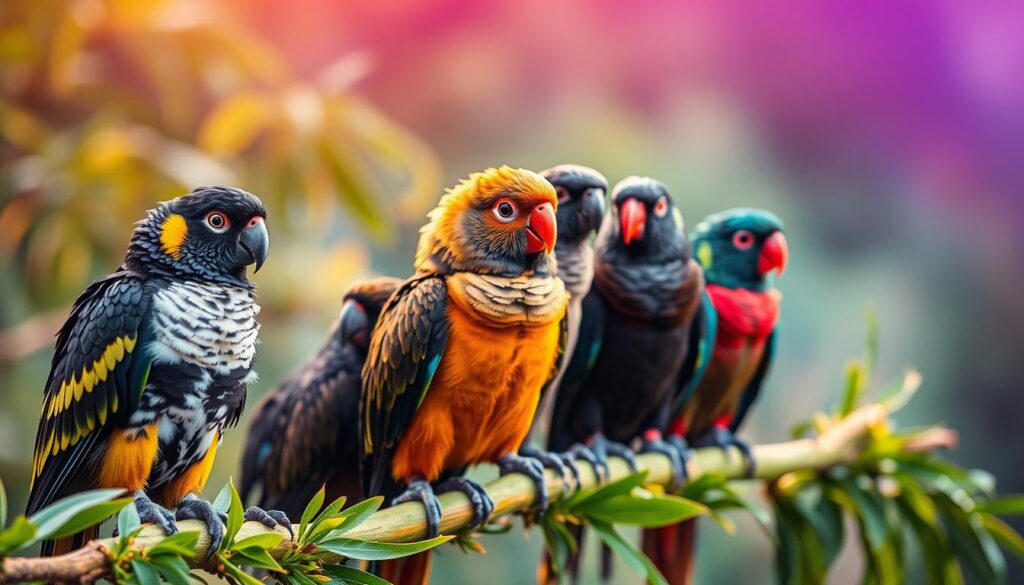Caique parrots are more than just birds; they are tiny bundles of joy. Their rainbow feathers and bold personalities make them special. These 9- to 10-inch birds come from South American rainforests and love attention and adventure.
They are known for their playful antics, like hanging upside down and climbing with their zygodactyl feet. This makes them the “clowns of the bird world.” But, their long lifespan of 25- to 30-years means caring for them is a big commitment.
Imagine a bird that needs two hours of your time every day. They crave social bonds and are as curious as a toddler. Their high-pitched calls and lively nature can brighten up any home. But, if they don’t get the right care, they might start feather plucking or screaming.
Proper care for caique parrots includes a big cage, fresh fruits, and new toys often. This guide will help you understand their needs and how to care for their vibrant spirits.
Caique Parrots
Caique parrots come from the Amazon basin in South America. They live in dense tropical forests in Brazil, Colombia, and nearby areas. These birds live in groups of 10 to 30, needing their natural homes to survive. In the wild, they can live up to 40 years, but in captivity, they live about 30 years.
Origins and Natural Habitat
Caique parrots live in the Amazon rainforests. They nest in tree holes and eat fruits, nuts, and insects. Their homes are threatened by deforestation, but their numbers are mostly stable. The white-bellied subspecies is an exception.
Distinctive Characteristics
These parrots weigh 150–170 grams and are 23 cm long. They have yellow, orange, green, and white feathers. Their strong beaks help them crack seeds, and their feet are good for climbing.
They love to play and even “surf” on soft things. It’s hard to tell if they are male or female because they look the same. They need a balanced diet to stay healthy, including pellets and fresh fruits.
Black-headed vs. White-bellied Caiques
| Feature | Black-headed | White-bellied |
|---|---|---|
| Scientific Name | Pionites melanocephalus | Pionites leucogaster |
| Head Markings | Black cap past eyes | Orange forehead |
| Beak Color | Black lower beak | Pinkish overall |
| Range | Colombia, Venezuela, Brazil | Brazil, Bolivia, Peru |
| Conservation | Least Concern | Vulnerable |
Both species are similar in size but have different head and beak colors. Black-headed caiques have a darker face, while white-bellied ones have a lighter head.
Caique Parrot Temperament and Personality

Caique parrots are lively friends who love to interact and play. They are known as “clown” parrots and need lots of caique parrot care. Their playful nature, like playing upside-down and moving a lot, shows they need fun places to be.
| Behavioral Trait | Key Detail |
|---|---|
| Energy Level | Requires 1+ hour daily exercise |
| Social Needs | 2+ hours of human interaction daily |
| Training Capacity | Can learn tricks and mimic sounds |
| Health Impact | Stress from neglect can cause feather plucking |
Playful Nature and Energy Levels
These birds are full of energy, hopping between perches or flipping to play with toys. They need big cages and lots of playtime to stay happy. Toys like swings and ladders help them use their energy in a good way.
Social Requirements
Caiques love being part of their family and need to talk and touch. If they don’t get enough attention, they might get into trouble. They enjoy watching and joining in on activities like cooking or reading.
Intelligence and Training
With the right caique parrot care, they can learn lots of tricks. They can even mimic sounds and short words. Regular training makes them happy and well-behaved pets.
Essential Housing Requirements

Caique parrots need a safe and fun place to live. They need a big cage to stay happy and healthy. Look for a cage that’s at least 30” x 36” x 30” with bars that are ½ to 5/8” apart.
Choose a cage made of powder-coated or stainless steel. This keeps it from rusting and protects against chewing. Place the cage in a family room but away from drafts and direct sunlight. Make sure it’s against a wall for safety.
Use different types of perches made from natural wood like Manzanita or applewood. The perch should be wide enough for the bird’s toes to wrap around ¾ of it. Don’t use sandpaper perches as they can hurt the bird’s feet. Keep food and water dishes on the cage sides to keep them clean.
Line the cage bottom with safe materials like recycled paper. This makes cleaning easier and keeps the bird healthy.
- Bar spacing: ½ to 5/8 inches prevents escape or injury.
- Temperature: Keep it between 65–75°F (18–24°C) for comfort.
- Toys: Change toys every month to keep the bird interested. Choose toys that are safe and won’t break easily.
| Bird Type | Minimum Cage Size (ft) |
|---|---|
| Finch/Canary | 1x1x2 |
| Cockatiel/Lovebird | 2x2x3 |
| Caique/Conure | 3x3x3 |
Always watch your bird when it’s out of its cage. Make sure the area is safe by removing harmful plants and small items. Secure windows to prevent accidents. Clean the cage regularly to keep your bird healthy and happy.
You May Like:- Sun Conure Cost: Pricing Details for This Vibrant Parrot
Caique Parrot Diet and Nutrition

Proper caique parrot diet is key to their health. A balanced diet keeps them vibrant and healthy. Avoid seed-only diets, as they lack important nutrients.
Pelleted foods like Lafeber NutriBerries and Kaytee Exact Rainbow should be 60–80% of their diet. They provide essential vitamins and minerals.
Daily Dietary Needs
Start with pelleted diets as the base. Add fresh produce for variety. Offer chopped fruits on skewers and mix vegetables like kale, broccoli, and carrots.
Weaning chicks need soft foods. Mix birdie bread with veggies and eggs. Keep two water bowls available, as many caiques dunk food before eating.
Recommended Fruits and Vegetables
- Vegetables: Include spinach, zucchini, peas, and sweet potato in a mix rotated every three days.
- Fruits: Apples, berries, and seasonal options like mango. Avoid citrus until the bird is acclimated.
- Proteins: Cooked egg, lentils, and small nut portions (walnuts, macadamia nuts).
Foods to Avoid
Never feed avocado, chocolate, or salty/fried foods. These can cause toxicity or obesity. Limit processed snacks to occasional treats during training.
Supplementation Guidelines
Pair pelleted diets with cuttlebone for calcium. Breeders use Cal-Mag with D supplements during breeding seasons. Always consult an avian vet before adding new supplements.
Health Considerations and Caique Parrot Lifespan

A healthy caique parrot can live for 25–30 years. Some may even reach 40 years with the right care. It’s important to watch for signs of health like bright eyes, active behavior, and clean feathers.
Any sudden changes in appetite, feather condition, or droppings are warning signs. These could mean there’s a health issue.
Common Health Issues
| Issue | Symptoms | Prevention |
|---|---|---|
| Respiratory Infections | Runny nose, labored breathing | Keep cage clean and draft-free |
| Feather Plucking | Over-preening, feather loss | Enrichment toys, reduce stress |
| Polyomavirus | Lethargy, appetite loss | Quarantine new birds, vaccinations |
| Psittacosis | Eye/nose discharge, breathing issues | Regular vet exams, hygiene |
Preventative Care
- Weekly weigh-ins to track health trends
- Clip wings and trim nails every 6–8 weeks
- Provide a pelleted diet with Nutri-Berries and fresh produce
- Sanitize cage weekly and replace bedding daily
- Yearly vet check-ups for early issue detection
Finding an Avian Veterinarian
It’s vital to find an avian specialist for complex issues. Use the Association of Avian Veterinarians to find qualified vets. Ask about their experience with caiques and what exams they do.
Regular health checks are key to a long, healthy life for your caique parrot. They help catch problems early.
Exercise and Enrichment Activities
Wild caique parrots spend hours foraging, flying, and exploring. Domestic birds need similar stimulation to prevent stress-induced caique parrot behavior issues like feather plucking. A University of California Davis study found that foraging enrichment reduced aggression and screaming in similar parrot species. Mimic this natural lifestyle through daily play and activity.
Provide at least three rotating toys weekly. Durable wood or rope toys encourage chewing, while puzzle feeders hide treats to mimic foraging. Homemade options like willow wreaths or cardboard tubes offer cost-effective solutions. Replace items every few months to prevent boredom.
- Physical exercise: Schedule 2-3 hours of supervised out-of-cage time daily for climbing and flying.
- Mental stimulation: Hide pellets under paper or use puzzle feeders to engage their problem-solving instincts.
- Social interaction: Training sessions and games like “find the treat” strengthen bonds while exercising their minds.
Parrots in barren cages often develop destructive habits. Introduce new objects weekly—a cardboard box fort or hanging leafy branches—to simulate wild exploration. Rotate perches of varying textures to exercise feet. Outdoor aviary access, if safe, provides natural sunlight and exercise.
Simple changes like rearranging cage toys or adding fresh branches can reset interest. Always prioritize safety: inspect ropes for fraying and remove small parts. Enrichment isn’t optional—it’s vital for the caique parrot’s health. A mentally stimulated bird stays healthy and happy.

Caique Parrot Behavior
Understanding caique parrot behavior is key to building a strong bond. These birds love to be around people and show their feelings through body language and sounds. Their playful side can hide their true needs, so it’s important to watch them closely.
Body Language and Vocalizations
Caiques talk to each other with eye pinning, raised crests, and tail flicks. A puffed-up body means they’re relaxed, but a stiff posture shows they’re stressed. Their sounds range from fun chirps to loud warnings, often when they’re playing.
Managing Territorial Behavior
These birds might protect their perches or toys, more so when they’re breeding. Slowly introducing new things can help reduce fights. Giving them their own spots for food and rest can also prevent squabbles. Their breeding instincts can make them more territorial, so it’s best to watch them when visitors come.
Preventing Behavioral Problems
- Change toys every week to stop feather plucking from boredom.
- Use positive training to handle biting or screaming.
- Make sure they get 3–4 hours of playtime a day to avoid loneliness stress.
Getting them to meet different people helps them not get too attached to one person. Early exposure to new things builds their confidence and reduces aggression. Keeping a regular routine and giving them safe toys, like branches, helps them stay healthy.
Caique Parrot Colors and Variations

Caique parrots have colors that amaze bird lovers. They show off green, orange, yellow, and white. These bright colors help them hide in the Amazon and tell us about their health and type.
Standard Color Patterns
There are mainly two types of caique parrots: black-headed and white-bellied. Here’s how they differ:
| Feature | Black-Headed Caique | White-Bellied Caique |
|---|---|---|
| Head Cap | Black extending past eyes | Orange-yellow crown |
| Beak Color | Black bottom, pink top | Uniform pinkish |
| Chest/Body | Orange-yellow underparts | White undersides with yellow highlights |
Rare Color Mutations
Sometimes, breeders get lutino, cinnamon, and pied birds. These colors come from genetic changes. But, these colors might not be healthy if bred wrong.
Wild birds usually have the same colors. But, in captivity, new colors can come from breeding. Always choose breeders who care about health, not just looks.
What to Consider Before Getting a Caique Parrot
Getting a caique parrot is a big decision. These birds can live up to 30 years. Before buying a caique parrot for sale, think about money, time, and ethics.
Cost Considerations
First, you’ll need to pay for the parrot, which costs $1,500–$2,500. You’ll also spend $500–$1,000 on a big cage, toys, and more. Monthly, expect to spend $100–$150 on food, vet visits, and new toys. Remember, unexpected vet bills can happen, so save for emergencies.
Time Commitment
Caique parrots need lots of attention. Owners should spend at least 2 hours a day playing, training, and socializing with them. They have lots of energy and can get destructive if ignored. Be ready for a 20–30 year commitment, as these birds form strong bonds and get lonely.
Ethical Sources
- Look for ethical breeders who focus on health and socialization.
- Adopting from rescues is a good option, as it reduces demand for backyard breeders.
- Stay away from unlicensed sellers, as 15% of caiques in shelters show signs of past trauma.
Always ask for health certificates and watch how the parrots interact with their parents. Ethical caique parrot for sale sources make sure birds are well-socialized to avoid aggression or fear.
Conclusion: Is a Caique Parrot Right for You?
Caique parrots are known for their bright colors and high care needs. They love to play and need daily interaction and mental challenges. These birds can live up to 30 years, so you must be ready for a long-term commitment.
It’s important to feed them right to keep them healthy. They should eat pellets, fresh fruits, and veggies to avoid health problems like bone diseases.
Think carefully before getting a caique parrot. They need lots of attention, exercise, and a safe place to live. Look for birds from licensed breeders or adoption programs to make sure they are healthy and well-cared for.
These birds are full of energy and do best in homes where people have time to train and play with them. With the right care, caique parrots can become lifelong friends. Make sure you do your research and talk to a vet before bringing one home.
FAQ
What are the main species of caique parrots?
The main species are the Black-headed caique (Pionites melanocephala) and the White-bellied caique (Pionites leucogaster).
What is the lifespan of a caique parrot?
With proper care, caique parrots can live 25 to 30 years.
What should be included in a caique parrot’s diet?
Their diet should include high-quality pellets (60-70% of their intake). Add fresh fruits and vegetables. Also, include cooked eggs and legumes as protein sources.
How can caique parrot owners promote positive behavior?
Use consistent training and manage their environment. Address any behavioral issues like boredom or lack of social interaction.
Are caiques good pets for families?
Yes, caique parrots are great for families. They are social, playful, and bond well with humans. But, they need lots of time and attention.
What are common health issues faced by caique parrots?
They often face respiratory infections, feather plucking, and nutritional deficiencies. Psittacosis is another issue. Regular vet visits are key.
How much living space do caique parrots need?
They need a cage of at least 30″ x 36″ x 30″. The bars should be 1/2 to 5/8 inches apart for safety.
What activities keep caiques mentally stimulated?
Engage them with supervised playtime, safe toys, and social interaction. Foraging activities also help keep them mentally sharp.
Are caique parrots easy to train?
Yes, they are intelligent and can learn tricks and commands. Positive reinforcement training works best.
How can prospective owners identify ethical sources for caique parrots?
Look for reputable breeders who focus on the birds’ health and socialization. Also, consider adopting from rescue organizations that support caiques.


